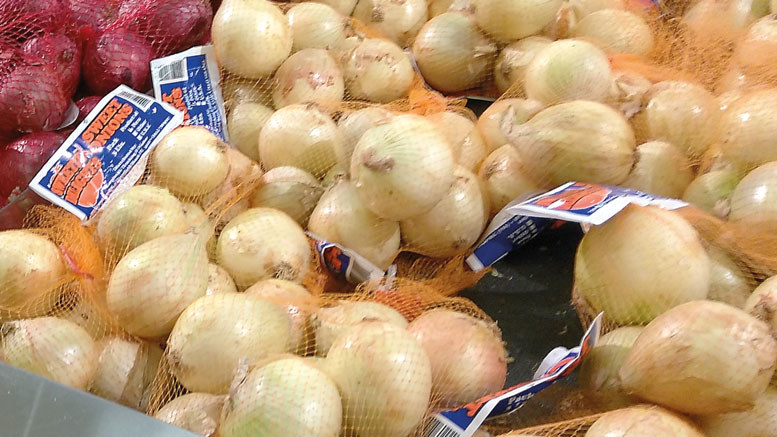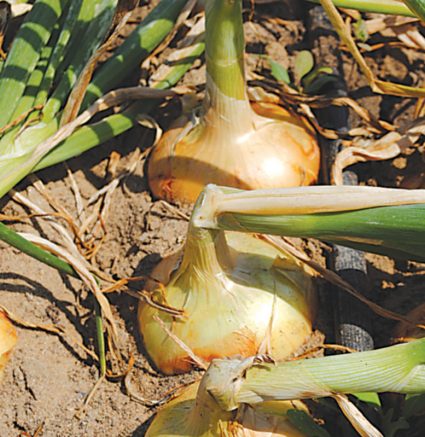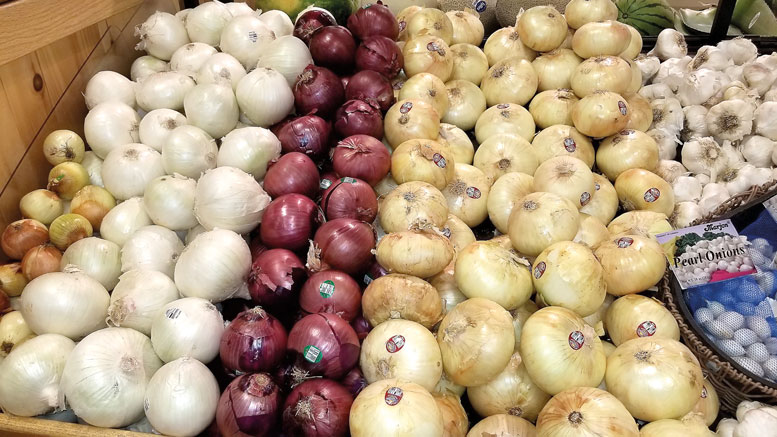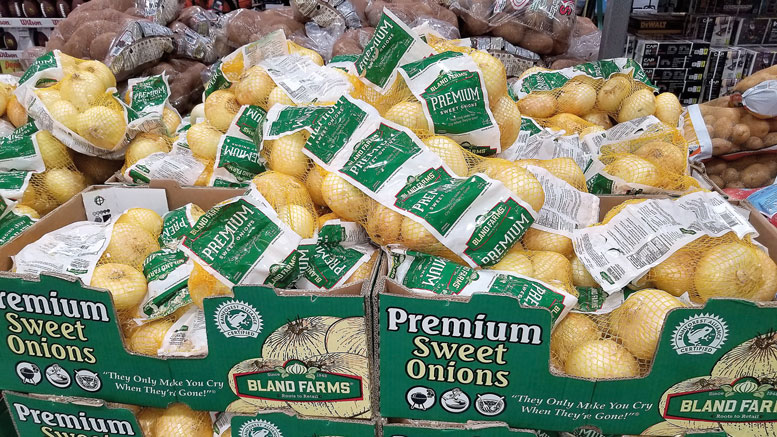Fall — A Sweet Time For Peru Sweet Onions
September 23, 2020 | 9 min to read


Originally printed in the September 2020 issue of Produce Business.
Peruvian onions bring high retail returns, fill shopping carts.
As fall bursts onto the scene, sweet onions from Peru charge across the field, scoring touch-downs for North American retailers clamoring to continue sales of the milder onion.
In August, after Vidalia and Walla Walla sweet onions stop shipping, Peru onions begin making their entrance. The Southern Hemisphere sweets become an integral part of the supermarkets’ year-round sweet onion program.


“People get use to the sweet onions,” says Sal Selletto, produce manager of the Middletown, NJ-based Food Circus/Foodtown’s Sea Girt, NJ, store. “They get spoiled on the Vidalias. When the Vidalias go out, it’s always a short season. People are still looking for sweet onions. The Peru sweet onions are not Vidalias, but they are a good quality onion that works well all winter. They sell quite well.”
Peru’s sweet onions maintain a reputation. “There’s no question about it. Peru is the best sweet onion that’s available this time of the year,” says Delbert Bland, president of Bland Farms LLC, which is headquartered in Glennville, GA. “We do what we call a globe-shaped sweet onion from the West also, but this flat-shaped sweet onion out of Peru is a superior product. Customers really seem to prefer them.”
“People get used to the sweet onions. They get spoiled on the Vidalias. The Peru sweet onions are not Vidalias, but they are a good quality onion that works well all winter.”
— Sal Selletto, Food Circus/Foodtown’s Sea Girt
Peru onions fill a need. “Peru has the best offer of sweet onions in the off-season,” says Bernardo Munoz, director of the Trade Commission of Peru in New York. “The quality is great and is available especially from early September to February. These are all planted and harvested by hand, achieving premium quality. The quality and caliber are very important for shoppers and retailers.”
Satisfying Demand
This year, when the Vidalia deal ended earlier than normal in mid-August following low Vidalia storage supplies, Peru helped keep retail shelves stocked with sweet onions. “Despite higher-than-normal consumer demand and a short supply of sweet onions this summer, Shuman Farms got a jump on this year’s Peruvian sweet onion crop and is a leader with imports to-date,” says John Shuman, president and CEO of Shuman Farms, Inc., headquartered in Reidsville, GA. “Compared to last year, the industry is trending up with imports. According to the USDA Market Report, shipments to retail for the industry are also up significantly season-to-date, entirely due to a shorter than usual Vidalia season.”


Peru sweet onions align well with the domestic Vidalias. “Peru is just as important for the time of year they come in as the Vidalias,” says Bland. “If we didn’t have Peru sweet onions, we wouldn’t have this flat sweet onion variety; it wouldn’t be available. When you get a customer buying that flat sweet onion every day during the summer with the Vidalias, they want to continue that same onion. People don’t want to switch to that globe-type onion.”
Peru sweet onions remain popular. “If you ask any retailer, sweet onions drive the category,” says Mike Blume, director of sales and marketing for Keystone Fruit Marketing, based in Greencastle, PA. “Peru sweet onions are a premium flat onion, available August through March, which helps maintain the supply of year-round sweet onions. Year-round sweet onions can generate 50% gross margin or more at retail.”
Peru sweet onions ship during the major U.S. holidays. “Holiday times can generate incredible sales: Thanksgiving, Christmas and New Years are always great times to promote,” says Blume. “At Keystone, we work with our retailer partners on specifically-designed promotions to help maximize sales throughout the year, but especially during the fall and winter months.”
Produce sales increase during the holidays. “Holidays are when food consumption goes up,” says Bland. “That time is very important to any retail produce executive. There are lots of good uses of sweet onions during the holidays.”
COVID Helping Sales
While other stores may reduce the size of their sweet onion displays in the fall and winter, because of COVID demand and fewer people dining at restaurants, Food Circus/Food town continues erecting sizable displays. “With more people cooking at home, we are featuring more displays of that kind of product,” says Selletto. “We tend to feature bigger displays of the loose onions. Onions sold extremely well when the pandemic first hit. I am happy to report onions remain a hot number.”
That increased demand benefits sweet onions. “People use to think nothing of going out at night to eat,” says Bland. “With all the changes, people are eating at home continuously. Sweet onion sales are very good at the retail stores that are catering more to the home-cooked meals.”


The variety of packaging that importers utilize utilize to market sweet onions helps sales. “We offer a wide variety of packaging options for retailers such as large display bins, consumer bags, display-ready containers and cartons designed to create meal solution opportunities in the produce department and drive incremental sales,” says Shuman. “We believe our Real-Sweet Peruvian sweet onions are the premium sweet onion that allows retailers to provide the same quality of sweet onion to our customers year-round, helping them build sales and consistency in the category.”
“Peru is the best country by far to grow onions due to the land, the environment, the working conditions and how the government looks at exports”
— Delbert Bland, Bland Farms
Sweet onions can be sold for $0.99 to $1.99 per-pound, with most common retails at $1.29 to $1.49, recommends Blume. “At these prices, they will sell,” he says.
Peru’s sweet onions also help in other ways. “Peru is the best country by far to grow onions due to the land, the environment, the working conditions and how the government looks at exports,” observes Bland.
Vidalia Double
Peru’s sweet onions are stand-ins for Vidalias, notes the Peru Trade Commission’s Munoz. “Among the varieties produced in the United States, the Vidalia onion stands out, grown especially in the state of Georgia, and its only limiting factor is its seasonality,” he says. “Although Peru could export as well in your season, if needed. The Peruvian sweet onion, which is similar to Vidalia, is the ideal substitute because its seasonality in Peru coincides with the window where American Vidalias are not available in the market.”
Peru sweet onions are also available in the marketplace during October, the month which shines attention on breast cancer awareness. For more than 25 years, the Pink Ribbon and the month of October have been associated with breast cancer awareness with the goal of raising funds for research and a cure.
In October, Shuman Farms will turn its sweet onion bags pink and offer display bins for an incremental sales opportunity in produce departments. It also creates in-store signage stores can use to boost sales by promoting the cancer-fighting antioxidants found in sweet onions. “We know that many people’s lives are impacted by breast cancer, and it is our privilege to be able to do our part, raise awareness and provide a donation to further research that will hopefully lead to a cure,” says Shuman.
Limited Organic Supplies
Organic sweet onions are available from Peru, but for a limited time. “There are limited supplies of organic sweet onions grown in Peru,” says Mike Blume of Keystone Fruit Marketing. “These organic sweet onions will be available in the U.S. for a short time, in November and December only.” Blume encourages retailers interested in Peru organic sweet onions to contact their suppliers early to ensure the stores’ needs are met.
Volume matches demand, however, and isn’t large, says Delbert Bland of Bland Farms. “It’s not as big as it could be,” says Bland. “I describe demand as level. People trust an onion more than they may for something like fruit, which have more of these insecticides. Onions don’t require the harsh chemicals and as many insecticides that some others use.”
In 2018, overall produce organic sales accounted for $17.4 billion. “The category continues to steadily increase year over year,” says John Shuman of Shuman Farms. “We know that today’s organic customers are very important to the produce department, especially as we continue to see the growth in this category. Our organic Peruvian sweet onions will be available in November.”
Large Displays Spur Sales
Displays of Peru sweet onions aren’t that different than displays of the Vidalias and Walla Wallas during the summer, observes Mike Blume of Keystone Fruit Marketing. “Big displays sell best, assuming you can sell through within a couple of days,” he says. “The big displays give the consumer a choice between loose and bags. If possible, a secondary display, especially 3-pound bags, can generate additional sales.”
There isn’t anything that necessitates displaying Peru sweet onions differently than their Vidalia sisters. “Retailers need to straight-up advertise them as a flat sweet onion,” advises Delbert Bland of Bland Farms. “The Peru and Vidalias should be merchandised identically. People know the Vidalia’s flatness and their pungency being so low. The characteristics of the Peru and Vidalia sweet onions are the same.”


Consumer consumption and purchase behavior research shows the average sweet onion consumer is 55 years old or older living in a two-person household with a $50,000–$75,000 annual income. The average consumer eats 1.6 pounds of sweet onions a year. “When sweet onions are in consumers’ market baskets, they are more likely to purchase fresh beef, tomatoes, potatoes, squash, mushrooms and peppers,” says John Shuman of Shuman Farms. “We encourage retailers to build cross merchandising displays in the produce department as well as the meat department to take advantage of these consumer buying habits and drive incremental sales.” The top dishes sweet onions are found in are salads, ethnic dishes and beef dishes.
Like other sweet onions, those from Peru need a bit more attention when placed on store shelves. “Because sweet onions don’t have the shelf life of a hybrid onion, it is critical to maintain display levels at what can be sold through within a day or two,” recommends Mike Blume of Keystone Fruit Marketing. “Secondary displays are always helpful in generating additional sales, too. And where possible, displays should include loose and bags, offering the consumer a choice.”
Bland recommends displaying Peru sweet onions away from other hot onions. “Retailers are better off with standalone displays and not to try to blend them in with the Western regular onions,” he says. “It’s a mistake when some stores try to blend them together and average the price. If a customers want buy Western onions and don’t care if they’re sweet or not, they will buy the cheapest onions they can get. But, if you separate Peru onions, you will get the premium price you need to get for them, and people will buy them.” Bland says he’s seeing more stores differentiating sweet onions.
Article 8 of 25

